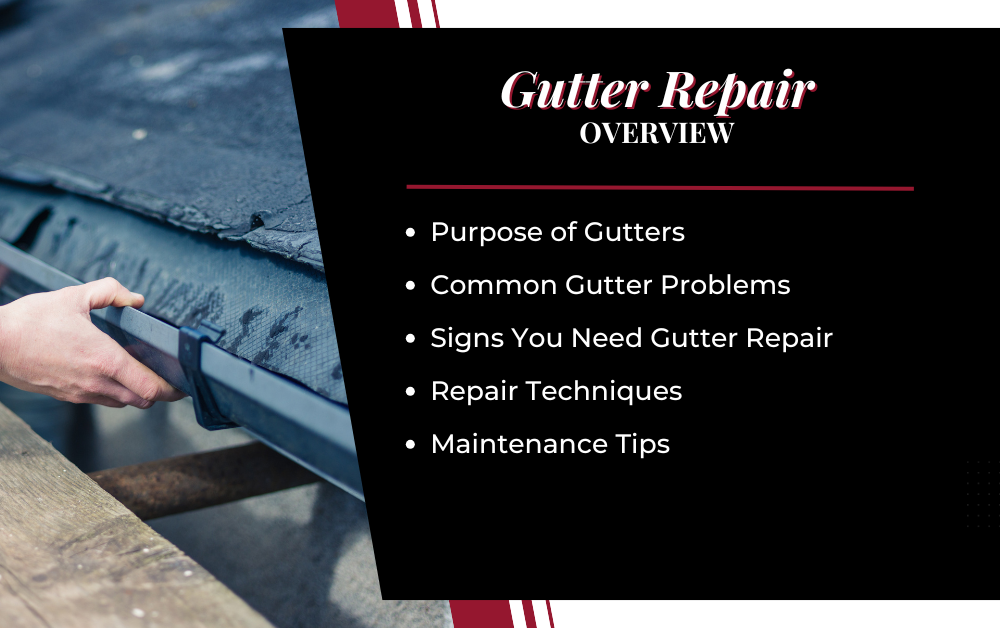Gutter repair is essential for the overall health of your home. Gutter repair is critical in preventing water damage and protecting your property from the elements. Understanding how gutters operate and the importance of ongoing maintenance can help you dodge costly fixes in the future. Dependable Roofing can help you explore the purpose of gutters, common problems, signs that you need repairs, effective repair techniques, and maintenance tips to keep your gutters in top shape. By being proactive about gutter care, you can guarantee your home remains safe, and you’ll feel a sense of security and accomplishment knowing that you’ve taken steps to protect your home.
Purpose of Gutters
Gutters carry rainwater away from your roof and foundation, preventing water from pooling around your home. This critical function is essential in maintaining the structural integrity of your property. Understanding this purpose will make you feel secure knowing your home is well-protected. When gutters effectively channel water away, they help protect your landscaping, preventing soil erosion and maintaining the aesthetics of your yard. Furthermore, well-maintained gutters shield your siding and windows from excess water, reducing the risk of costly repairs due to water infiltration. Through effective water management, you can develop a healthier living environment.
Directing Rainwater
Gutter systems effectively channel water away from vulnerable areas of your property. This protects the foundation and prevents potential flooding in basements and crawl spaces. Proper drainage is essential during heavy rainstorms, as it minimizes the risk of water accumulating around the base of your home. Without a reliable gutter system, you risk significant deterioration that can affect the stability of your structure. Thus, the role of gutters in directing rainwater cannot be overstated.
Preventing Water Damage
Well-maintained gutters are crucial in shielding your siding and windows from excess water. Water overflows or leaks can seep into these areas, leading to mold, rot, and structural damage. Rectifying these issues often leads to high expenses and extended time commitments, making preventive measures essential. Ongoing gutter maintenance enhances the longevity of your gutters and safeguards other aspects of your home. You can avoid water damage affecting your property’s interior and exterior by ensuring proper drainage.
Reducing Mold and Mildew Risk
Proper drainage helps create a healthier living environment by minimizing mold or possible mildew to grow. When gutters are clogged or damaged, moisture can linger in areas that promote fungal growth. This poses health risks to inhabitants and leads to further property deterioration. Maintaining your gutter system is crucial in keeping indoor air quality high and preventing unwanted allergens. Addressing gutter issues promptly reduces the likelihood of mold and mildew taking root in your home.
Common Gutter Problems
Despite their importance, gutters can encounter various issues over time. One of the most common problems is the development of leaks and holes, often caused by rust, corrosion, or physical damage. These leaks can lead to water escaping the gutter system, undermining its effectiveness and potentially causing water damage to your home. Clogs are another frequent issue; debris such as leaves, dirt, and twigs can accumulate, obstructing water flow. Periodic cleaning of your gutters is vital to prevent these clogs from occurring. Blockages from leaves and debris can cause water to overflow, potentially damaging your home’s exterior and foundation.
Leaks and Holes
Leaks and holes in gutters can develop from various factors, including age and weather conditions. Rust and corrosion are common culprits, especially in metal gutters, while physical damage can occur from falling branches or heavy debris. When left unaddressed, these leaks can worsen over time, leading to more significant issues like water damage to your home. Identifying and sealing these leaks promptly is essential for maintaining your gutter system’s functionality. To identify leaks, you can inspect your gutters when it’s raining or use a hose to simulate rain. Once identified, you can use a gutter sealant or patch to seal the leak. Regular assessments can help pinpoint these problems sooner, preventing costly repairs.
Clogs
Clogs are a prevalent issue that can significantly impede the performance of your gutters. When leaves, twigs, and other debris accumulate, they obstruct water flow, causing it to back up and overflow, damaging the gutters and harming your home’s exterior and foundation. Routine maintenance and cleaning are required upkeep to prevent clogs from recurring. Installing gutter guards, which provide a protective layer to prevent debris from accessing the gutter, can also minimize debris accumulation, making your gutter system more efficient.
Sagging and Detachment
Sagging gutters can result from improper pitch or debris overload, leading to ineffective drainage. If left unaddressed, sagging can cause gutters to detach from the house, compromising their function. This detachment often occurs due to excessive weight or improper installation techniques. Regularly checking the alignment of your gutters ensures they remain securely attached and function as intended. Addressing these issues prematurely can mitigate the need for significant repairs and enhance the appearance of your home.
Signs You Need Gutter Repair
Identifying the indications that your gutters need repair is crucial for preventing more extensive damage. When you can identify these signs, you’ll feel a sense of reassurance, knowing that you are in control and can prevent potential damage. One of the most apparent indicators is water spilling over the sides of the gutters, which often suggests that your system is clogged or damaged. You may also notice stains on the siding or foundation, which can result from water overflow. Additionally, pooling water near the foundation is a red flag; it suggests that the gutters are not effectively channeling water away from your home. Finally, visible rust, holes, or cracks in the gutter material and signs of insects or vegetation growing inside indicate that repair is necessary.
Overflowing Water
When you see water spilling over the edges of your gutters, it’s a clear sign that something is wrong. This overflow often indicates clogs that prevent water from flowing through the system. Overflowing water can significantly damage your home’s foundation and landscaping if not addressed. Monitoring your gutters during rainstorms can help you catch this issue early. Taking timely action can save you from more severe consequences down the road.
Stains and Pooling
Stains on your siding or foundation often indicate water has escaped the gutter system. Such stains can be visually displeasing and might contribute to additional issues if moisture continues to penetrate the walls of your home. Pooling water near the foundation is another concerning sign, as it can cause erosion and weaken your home’s structural integrity. Addressing both matters swiftly is essential to prevent costly repairs.
Visible Damage and Growth
Visible rust, holes, or cracks in the gutter material indicate that your gutters are distressed. These issues compromise the gutters’ ability to function correctly and can lead to further water damage. Additionally, insects or vegetation growing in your gutters signals that they are not draining effectively. These symptoms should trigger urgent measures to address the fundamental problems.
Repair Techniques
There are several effective techniques to consider when it comes to gutter repair. Sealing leaks is a standard method; you can use waterproof sealants or roofing cement to patch small holes. Cleaning the area meticulously is vital before applying any sealant to ensure a strong bond. Clearing clogs is equally crucial, as it restores the water flow and prevents overflow. Adjusting the pitch of your gutters is another critical step; ensuring they slope toward the downspouts will facilitate efficient drainage.
Sealing Leaks
Sealing leaks in your gutters can prevent water from escaping and causing damage. You can effectively patch small holes using waterproof sealants or roofing cement. Before applying any sealant, cleaning the affected area is crucial to ensure optimal adhesion. This minor adjustment can increase the durability of your gutters and maintain their functionality.
Clearing Clogs
Clearing clogs is essential for maintaining the performance of your gutters. Removing debris using a scoop or trowel can help restore proper water flow. For stubborn clogs, flushing the gutters with a hose can effectively dislodge the debris. Regular cleaning keeps your gutters functioning and prevents overflow and damage to your home. Establishing a cleaning schedule can make this task more manageable and avoid future issues.
Adjusting Pitch and Reattaching
Adjusting the pitch of your gutters ensures they slope correctly toward the downspouts. This simple adjustment can significantly improve drainage and reduce the risk of overflow. If gutters have become detached, securely reattaching them using screws or brackets is essential for restoring their functionality. Regularly checking the alignment of your gutters helps maintain their performance over time. Dealing with these problems proactively can save you from more extensive repairs and keep your gutter system in good shape.
Maintenance Tips
Cleaning your gutters at least twice a year helps prevent debris accumulation. Installing gutter guards can also minimize the buildup of leaves and twigs, making maintenance easier. Regularly check downspouts for blockages and ensure they direct water away from the foundation. After heavy storms, inspect your gutters for any signs of damage or clogs to address issues before they escalate.
Regular Cleaning
Establishing a routine for gutter cleaning is vital for keeping them clear and functioning correctly. By committing to cleaning your gutters at least twice per year, you can prevent blockages and ensure proper drainage. During cleaning, it’s essential to check for any signs of potential damage or wear that may require repair. A clean gutter system is less likely to overflow and cause water damage to your home.
Installing Gutter Guards
Consider installing gutter guards to decrease the debris buildup of leaves and twigs. These protective installations can dramatically reduce the need for gutter cleaning while ensuring proper drainage. Gutter guards allow water to travel without obstruction while keeping larger debris, like twigs, out, making maintenance easier. Investing in gutter guards can enhance your system’s efficiency and lifespan.
Post-Storm Inspections
After heavy storms, it’s essential to inspect your gutters for signs of damage or clogs. Storms can cause debris to accumulate quickly, leading to potential overflow issues. Checking your gutters after inclement weather helps you address any problems before they escalate. By remaining vigilant, you can protect your property from moisture damage while sustaining the integrity of your gutter system.
Conclusion In conclusion, staying proactive about gutter repair is essential for maintaining the integrity of your home. By understanding the purpose of gutters, recognizing common problems, and employing effective repair techniques, you can safeguard your property against water damage. Don’t wait for minor issues to become major repairs—take action today to ensure your gutters are in excellent condition. For professional assistance or more information on gutter repair, contact Dependable Roofing today to protect your home!




